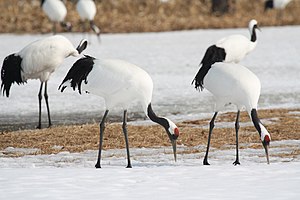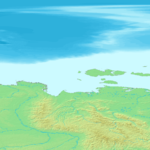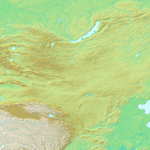http://en.wikipedia.org/wiki/Nanai_people
The Nanai language (also called Gold or Hezhen) is spoken by the Nanaipeople in Siberia, and to a much smaller extent in China's Heilongjiangprovince, where it is known as Hezhe.
Tungusic peoples are:
- Evenks
- Evens
- Manchus (Jurchens)
- Negidals
- Nani people
- Oroch people
- Orok people
- Oroqen people
- Udege people
- Ulchs
- Xibe
The word originated in Tunguska, a region of eastern Siberia bounded on the west by the Tunguska river[2] and on the east by the Pacific ocean.
The largest of the Tungusic peoples are the Manchu who number around 10 million. They are originally from Manchuria, which is now Northeast China but following their conquest of China in the 17th century, they have been almost totally assimilated into the main Han Chinese population ofChina. This process accelerated especially during the 20th century. The non-assimilated culture and language is still present in parts of northern China.
Evenks live in the Evenk Autonomous Okrug of Russia. The Udege(Удэгейцы in Russian; ethnonym: удээ and удэхе, or udee and udehe correspondingly) are a people who live in the Primorsky Krai andKhabarovsk Krai regions, also in Russia.
| Korean (South Korea) | 0.010 | 103 | Derenko 2007 | Y=1 |
| Hmong (Jishou, Hunan) | 0.010 | 103 | Wen 2005 | Y=1 |
| Korean (South Korea) | 0.011 | 185 | Jin 2009 | Y1=1, Y2=1 |
| Nivkh (northern Sakhalin) | 0.661 | 56 | Starikovskaya 2005 | Y1=37 |
| Nanai | |||||||||||||||||||||||||||||||||||||||||||||||||||||||||||||||||||||||||||||||||||||||||||||||||||||||||||||||||||||||||||||||||||||||||||||||
|---|---|---|---|---|---|---|---|---|---|---|---|---|---|---|---|---|---|---|---|---|---|---|---|---|---|---|---|---|---|---|---|---|---|---|---|---|---|---|---|---|---|---|---|---|---|---|---|---|---|---|---|---|---|---|---|---|---|---|---|---|---|---|---|---|---|---|---|---|---|---|---|---|---|---|---|---|---|---|---|---|---|---|---|---|---|---|---|---|---|---|---|---|---|---|---|---|---|---|---|---|---|---|---|---|---|---|---|---|---|---|---|---|---|---|---|---|---|---|---|---|---|---|---|---|---|---|---|---|---|---|---|---|---|---|---|---|---|---|---|---|---|---|---|
| Нанай, Нанайэ (Nanaj, Nanaje) | |||||||||||||||||||||||||||||||||||||||||||||||||||||||||||||||||||||||||||||||||||||||||||||||||||||||||||||||||||||||||||||||||||||||||||||||
| Native to | Russia, China | ||||||||||||||||||||||||||||||||||||||||||||||||||||||||||||||||||||||||||||||||||||||||||||||||||||||||||||||||||||||||||||||||||||||||||||||
| Region | Siberia, Heilongjiang | ||||||||||||||||||||||||||||||||||||||||||||||||||||||||||||||||||||||||||||||||||||||||||||||||||||||||||||||||||||||||||||||||||||||||||||||
| Ethnicity | Nanai people Sakhalin Oblast, Vowels and vowel harmony[edit]
The Nanai language has seven phonemic vowels: /i, u, y, o, œ, a, ə/. There are twelve allowed diphthongs: /ai, ao, əi, əo, ia, iə, io, iu, ua, ui, uo, oi, ya, yə/; there are also two allowed triphthongs: /iao, uai/. Phonemic vowels change as follows based on surrounding consonants:[16]
The following table summarises the rules of vowel harmony.
Consonants[edit]
As for consonants, there are twenty-eight:
Phonemic consonants may optionally change as follows:[18]
Dialects[edit]
Phonology of the various dialects of Nanai has been influenced by surrounding languages. Tolskaya specifically noted several phonological peculiarities of Bikin dialect which may indicate influence from Udege, including monopthongisation of diphthongs, denasalisation of nasal vowels, deletion of reduced final vowels, epenthetic vowel preventing consonant final words, and the deletion of intervocalic [w].[19]
| ||||||||||||||||||||||||||||||||||||||||||||||||||||||||||||||||||||||||||||||||||||||||||||||||||||||||||||||||||||||||||||||||||||||||||||||

The Nanais are mainly Shamanist, with a great reverence for the bear (Doonta) and the tiger (Amba).


Also; ethnic Nanai descent from Northeast China, and was born in Heilongjiang, China
| Heilongjiang Province | |
|---|---|
| Province | |
| Name transcription(s) | |
| • Chinese | 黑龙江省 (Hēilóngjiāng Shěng) |
| • Abbreviation | 黑 (pinyin: Hēi) |
| Map showing the location of Heilongjiang Province | |
| Coordinates: 48°N 129°E | |
| Manchu script | ᠰᠠᡥᠠᠯᡳᠶᠠᠨ ᡠᠯᠠThe agriculture of Heilongjiang, heavily defined by its cold climate, is based upon crops such as soybeans, maize, andwheat. Commercial crops grown include beets, flax, and sunflowers.
| ||||||||||
|---|---|---|---|---|---|---|---|---|---|---|---|
The Nanai/Hezhe language belongs to the Manchu-Tungusic languages.
Russia
Ukraine
Manchu,China

http://en.wikipedia.org/wiki/Khabarovsk_Krai
| Khabarovsk Krai | |||
|---|---|---|---|
| Хабаровский край (Russian) | |||
| — Krai — | |||
| |||
| Anthem: None | |||
| Coordinates: 54°48′N 136°50′ECoordinates: 54°48′N 136°50′E | |||
| Political status | |||
| Country | Russia | ||
| Federal district | Far Eastern[1] | ||
| Economic region | Far Eastern[2] | ||
| Established | October 20, 1938 | ||
| Administrative center | Khabarovsk | ||
Siberia (/saɪˈbɪəriə/; Russian: Сиби́рь, tr. Sibir', IPA: [sʲɪˈbʲirʲ] (
| Physical map of Northern Asia. | ||
|---|---|---|
















